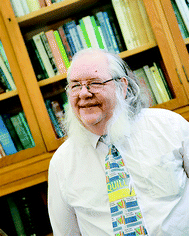Obituary: Kenneth R. Seddon: 1950–2018
First published on 2nd February 2018
Prof. Ken Seddon died on 21 Jan 2018 and the green chemistry community has lost one truly original character. Ken was in many ways a larger than life figure and the image he cultivated was one designed to elicit a reaction. Like the ionic liquids he devoted much of his career to, this often resulted in polarisation into positives and negatives. He could be in equal measure, generous, supportive, challenging, and yet also dismissive, quick to judge and then as immovable as a rock. Amongst those of us around the world who counted him as a colleague, supervisor, mentor, or collaborator though, he evoked deep-seated loyalty and friendship. He could be gracious, charming and thoroughly inclusive and had an infectious enthusiasm for science.
Let's consider just what it was that Ken achieved. He published over 400 papers with 44 of these in Green Chemistry, starting with one in the very first issue (Diels–Alder reactions in ionic liquids. A safe recyclable alternative to lithium perchlorate–diethyl ether mixtures, Green Chem., 1999, 1, 23–25). In 2011, he found himself as the highest ranked UK chemist in the Times Higher Education ‘Top chemists of the past decade’ survey, and was awarded an OBE in 2015 for his services to chemistry.
But let's be clear, Ken did not invent ionic liquids, and he never claimed to have! He was not even the first to make use of ionic liquids in electrochemistry, synthesis, catalysis, or as new solvents.
What he did do, and he did this remarkably well, was to recognise that there was a need to unify the disparate niche research areas where ionic liquids were under investigation and to create a broader new research landscape. As such, his greatest impact on science, and on green chemistry in particular, is through the popularisation of the idea that ionic liquids might actually be interesting and useful liquids to study – indeed, that they might be ‘neoteric solutions’.
Ken was a populist, although playing by his own rules, who worked tirelessly to promote the idea that ionic liquids could have a role in every area of science and technology and engaging with scientists across disciplines and industries from around the globe to make it possible. In doing so he demonstrated that liquids that also did not obey the rules could be used in new ways, reinforcing the concept that ionic liquids, although not intrinsically ‘green’ in themselves (and much has been written on this topic) could be an invaluable part of the green chemistry tool box. He established QUILL (the Queen's University Ionic Liquids Laboratory) as the first university–industry collaborative research centre dedicated to ionic liquids research in 1998, welcoming researchers from across the globe.
Is the widespread acceptance and integration of ionic liquids into the scientific lexicon his greatest lasting legacy? Or is it the way in which he was able to coax a global ionic liquid community into being one that works together, by and large, in cooperation and collaboration rather than in frenetic competition.
The modern, global ionic liquids community will miss one of its founding fathers.
Dr John Holbrey
QUILL and School of Chemistry, Queen's University Belfast
Prof. Tom Welton OBE
Dean of the Faculty of Natural Sciences, Imperial College London
| This journal is © The Royal Society of Chemistry 2018 |


